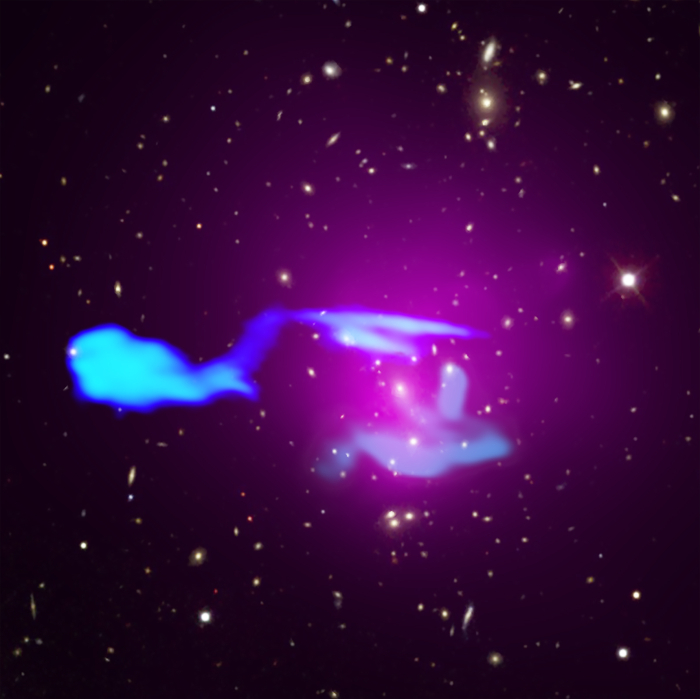
 Credit: X-ray: NASA/CXC/Leiden Univ./F. de Gasperin et al; Optical: SDSS; Radio: LOFAR/ASTRON, NCRA/TIFR/GMRT
Credit: X-ray: NASA/CXC/Leiden Univ./F. de Gasperin et al; Optical: SDSS; Radio: LOFAR/ASTRON, NCRA/TIFR/GMRT
Impulse Power
Clusters of galaxies are the most massive bound components in the Universe. They contain hundreds or thousands of galaxies. Most of the mass in these clusters is contained in invisible components: dark matter (which we can't see but which the galaxies in the cluster can feel) and normal matter that's so hot it can only be observed by the X-ray emission it produces. In addition to these components, galaxy clusters also contain high speed particles moving near the speed of light. Some of these particles are produced by powerful particle jets from active, supermassive black holes at the centers of some of the cluster galaxies. But our full understanding of these high-speed, "relativistic" particles, how they are produced and how long they survive, has proven elusive. A new study of the galaxy cluster known as Abell 1033 has now provided some important clues regarding the nature of the population of relativistic particles in this cluster. This study used low-frequency radio emission measured by the LOFAR radio telescope array combined with X-ray observations of the extremely hot intracluster medium measured by the Chandra X-ray Observatory. The radio emission is shown in blue in the image above, while the X-ray emission is shown in purple; the X-ray and radio images are superimposed on an optical image of the cluster. The interesting distortion of the radio emission is believed to be a consequence of the motion of the galaxies in the cluster, and of the intra-cluster medium itself. The relative brightness of the radio emission suggests that this emission is produced by a population of older, relativistic electrons re-energized and rejuvenated by a gentle impulse due to turbulence in the slower matter bound to the cluster.
Published: December 10, 2018
<
HEA Dictionary ● Archive
● Search HEAPOW
● Other Languages
● HEAPOW on Facebook
● Download all Images
● Education ● HEAD
>

Each week the HEASARC
brings you new, exciting and beautiful images from X-ray and Gamma ray
astronomy. Check back each week and be sure to check out the HEAPOW archive!
Page Author: Dr. Michael F. Corcoran
Last modified Monday, 26-Feb-2024 17:34:08 EST


